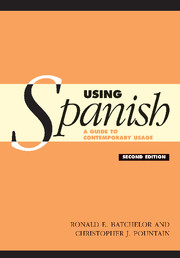Book contents
- Frontmatter
- Contents
- Authors' acknowledgements
- Preface to the second edition
- List of abbreviations and symbols
- Glossary
- The Spanish speaking world: countries where Spanish is spoken, with an estimate of the numbers of native speakers
- 1 Introduction
- 2 Passages illustrating register and local variety
- Part I Vocabulary
- Part II Grammar
- 21 Gender
- 22 Number
- 23 Word order
- 24 Prepositions
- 25 Prepositional constructions with verbs, nouns and adjectives
- 26 Constructions with verbs of movement
- 27 Negation
- 28 Use of tenses
- 29 Periphrastic verb forms
- 30 Modal auxiliaries
- 31 The Subjunctive
- 32 ser and estar
- 33 Personal pronouns
- 34 The reflexive
- 35 Comparison
- 36 Usage with names of countries
- Index
30 - Modal auxiliaries
Published online by Cambridge University Press: 05 June 2012
- Frontmatter
- Contents
- Authors' acknowledgements
- Preface to the second edition
- List of abbreviations and symbols
- Glossary
- The Spanish speaking world: countries where Spanish is spoken, with an estimate of the numbers of native speakers
- 1 Introduction
- 2 Passages illustrating register and local variety
- Part I Vocabulary
- Part II Grammar
- 21 Gender
- 22 Number
- 23 Word order
- 24 Prepositions
- 25 Prepositional constructions with verbs, nouns and adjectives
- 26 Constructions with verbs of movement
- 27 Negation
- 28 Use of tenses
- 29 Periphrastic verb forms
- 30 Modal auxiliaries
- 31 The Subjunctive
- 32 ser and estar
- 33 Personal pronouns
- 34 The reflexive
- 35 Comparison
- 36 Usage with names of countries
- Index
Summary
English has a relatively large number of auxiliary verbs (eg will, would, may, might, shall, should, must, ought) and verbal expressions (to be to: ‘we were to arrive at nine’; to have to: ‘we had to go’). Their main function is to express intentions or opinions (commands, possibility, etc). There is no straightforward match between these and their Spanish equivalents: Spanish has a rather smaller number of auxiliary verbs (eg deber, poder, querer) and verbal expressions (tener que hacer algo, haber de hacer algo). The major differences between Spanish and English are:
1 Spanish auxiliaries may usually be used in all tenses (eg puede, podía, podría, ha podido, pudo, etc) while English auxiliaries have a maximum of two (which may in any case have independent modal values, eg may, might) and sometimes only one (eg must).
2 In English, the Perfect auxiliary have is used only with the dependent infinitive (He may have done it), whereas in Spanish haber is used either with the dependent infinitive (podría haberlo hecho) or with the modal auxiliary (Habría podido hacerlo). There is a good deal of overlap in the values of modal auxiliaries in both Spanish and English: English It will be six o'clock or It must be six o'clock; Spanish Debes hacerlo or Tienes que hacerlo. Also, an auxiliary may have several modal functions: English can is associated with ability and possibility; Spanish deber with obligation and inference.
The following tables are presented according to categories of meaning rather than taking each modal auxiliary separately, and the equivalences given are necessarily rather vague.
- Type
- Chapter
- Information
- Using SpanishA Guide to Contemporary Usage, pp. 384 - 388Publisher: Cambridge University PressPrint publication year: 2005



